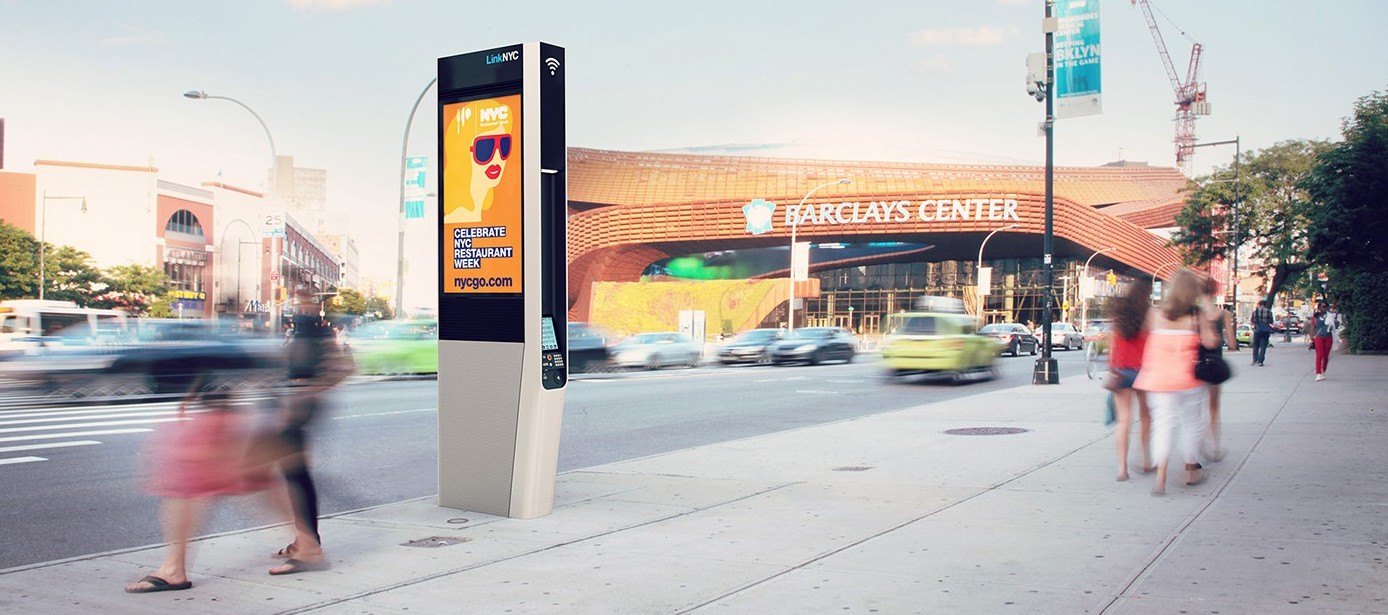
CIVIQ’s Gleeson On Progress Of LinkNYC Smart City Efforts
May 10, 2017 by Dave Haynes
Here is the first of a two-part Q&A session with digital signage veteran Brad Gleeson, now the Chief Commercial Officer at CIVIQ, on that company’s smart cities efforts in New York and beyond.
The completed Q&A was provided to 16:9 by a Samsung agency, but they’re the sorts of questions I’d ask. I thought about it, and concluded the Q&A content passed my sniff test on editorial versus advertorial.
LinkNYC is obviously a massive undertaking. Converting payphones and spreading out technology across an entire city is no easy task. How did CIVIQ approach this?

Brad Gleeson
As you can imagine, a project of this kind in one of the world’s largest and busiest cities is a real challenge and we’re not alone in that project. The project itself is owned and managed by a consortium of companies, of which CIVIQ is one of the partners. The other partners are Intersection and Qualcomm. Together, we have resources who work together as a team to manage the deployment and operation of the network.
In addition to that we have third-party contractors and service providers that we’ve each hired that are specialists in the engineering work and the construction work and the service and maintenance functions that we require to maintain such a large network.
The planning is done in cooperation with representatives from the city and various agencies and we basically have a team of people who are constantly reviewing the location, making sure that where we’re putting the structures are the best places we can locate them at and what we can do to become as efficient as possible.
In the deployment process, we’re approaching the 1,000th unit, I don’t think we’re quite there yet but we have 7,000 more to go. So it’s going to be a long-term, probably three to four year process to get them all deployed. We’re getting better at it as we go, I would say.
Obviously New York can see extreme weather throughout the year with snow storms, hurricanes, and very hot summers. What technical preparations were made to ensure the Link machines will survive their environment?
I would say that probably our primary value-add to the project is the legacy and history that the company has.
Originally, CIVIQ was a spin out of a company called Comark and Comark manufactures ruggedized display and computer equipment to go on battleships and that are used in extreme industrial applications. So we have some history of how to manufacture devices that needed to be able to withstand the elements as well as extreme temperatures and difficult environments.
So these devices are engineered to basically survive being exposed to the elements and to the public for more than 10 years.
The engineering that goes into that means that all the components need to be very heavily tested and manufactured and the whole unit needs to be completely sealed against the environment. We have a patented cooling system and other technologies that we use to reduce the amount of internal heat that the devices have to withstand and then to keep moisture out of the devices.
So yes, it’s a big challenge and one that I would say only a handful of companies in the world could take on at this scale. It’s really the basis for CIVIQ’s capabilities within the project.
In a similar vein, New York is home to a huge amount of diverse people. Were there any considerations made around accessibility?
Absolutely. The idea was we had to make these devices replace public payphone booths which also had been designed for accessibility for the handicapped. There’s a regulation in the United States called the Americans with Disabilities Act which lays out very clearly what sort of requirements there are for public devices that could be accessed by the disabled.
So yes, we have Braille information on the displays, the tablets themselves are placed in a location that makes them accessible to people in wheelchairs, we’re currently installing hearing loops which are for the hearing impaired on the devices as well.
So yes, absolutely. The idea was to make the devices accessible to all and useful to all and we’ve gone to great lengths to make that happen.
What benefits do you see these machines bringing to the people of New York?
A big justification for the network that was created by Mayor Michael Bloomberg and then Mayor Bill de Blasio was what they call ‘closing the digital divide’. There was roughly 30% of the population of New York that did not have regular access to broadband internet.
In many cases students whose homework was posted on the internet had to go to McDonald’s or Starbucks or someplace away from home in order to see their homework. People who needed to use the internet to search for a job or to find a doctor or whatever had a difficult time getting access to information that most of us take for granted.
So a big change to this community is just reliable access to the benefits of the World Wide Web and the internet technology that most of us, like I say, take for granted.
Other than that, the other part of it was really a creation of a neighborhood touch point which could be used to provide a wide range of access and information to people in the area. So the use of the wayfinding to help people find their way, not just to a restaurant or a movie or something like that but to get access to transit applications, to mass transit so that they could reduce the cost of their commute or could manage to get to places more cost effectively.
And also very importantly, the City 311 app which New York is invested heavily in to engage citizens and information that the city needs to share as well as to get information back from citizens issues that are important to them, I think has been a tremendous benefit.
So we’re still exploring all the ways that the device can help the city and its residents. We’re investigating new applications, new use cases and in the case of CIVIQ’s expansion of the concept into other cities, we’re actively engaged with a wide range of other cities on how they would like us to use this sort of urban technology to solve or help problems that each of those cities have which are unique to them.
For any city, security and safety are important issues. In the case of a sudden emergency, natural or otherwise, how will the Link machines perform and are there features that will make them useful in these situations?
Yes, absolutely. All of the devices have battery backup and they have large, bright, Samsung LCD screens that can be used to alert the public to an emergency event and instruct them as to how to prepare for that or to get help.
They also have 911 buttons and so they’re immediately connected to first responders in the case of a localized emergency. And the battery backup maintains the function of at least the Wi-Fi, but other functionality can also be enabled for some period of time after the power is out to extend this functionality in the case of an emergency.
You mention the use of cameras and not taking personal information. I think that segues well into the aspect of cyber security. What preparations have been made to defend the Link machines from hackers and other security issues?
We worked hard on first of all a privacy policy, which we believe is among the most advanced in the world at this point. So we’re very, very, I think, aware of the importance of maintaining the privacy of our users and the people utilizing the network.
So first of all our Wi-Fi network offers two versions; an open version and a secure version. The secure version is encrypted end to end and utilizes token technology to make sure that all users’ information and data is very securely protected.
None of the data that we collect and utilize is made available to the public. It’s very carefully managed and used specifically just for measuring the effectiveness and utilization and capabilities of the network and the system itself.
The advertising displays and all the information that goes across the systems is on our own private network which is, again, very secure and managed internally by our team.
So I would say we’ve taken extraordinary steps to ensure the security and privacy of the network. Nothing is 100% foolproof, as you’ve seen from all the different ways that various groups have had their security breached, but I would say we’ve done everything possible in the current state of the art to make sure that we’ve protected the data and privacy and security of the information that our users are entrusting us with.
Tomorrow – Monetizing the network



Leave a comment